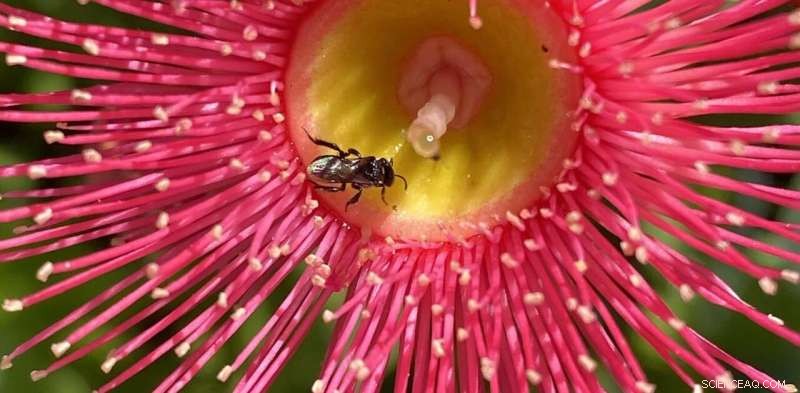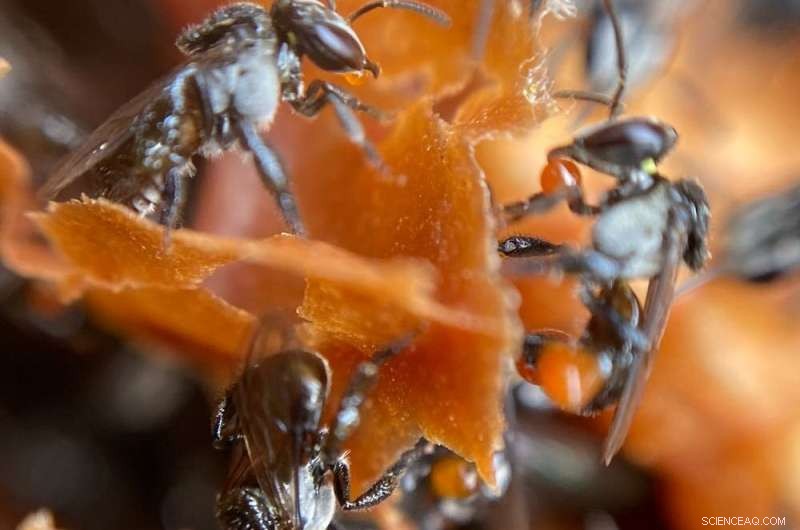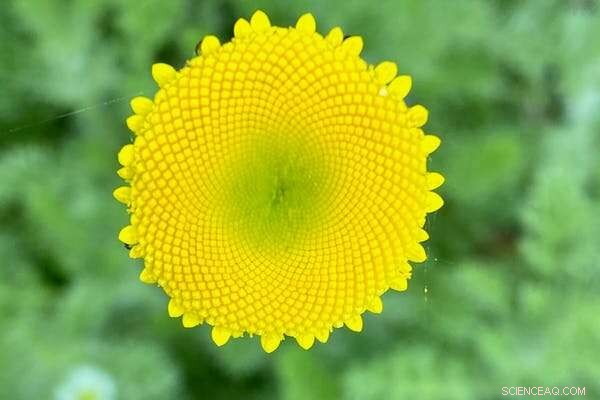
Crédito:Judy Friedlander, Autor fornecido
A taxonomia já foi domínio de cientistas de jaleco branco com anos de treinamento universitário. Embora essa experiência ainda seja importante, os australianos estão ajudando cada vez mais a identificar espécies por meio de aplicativos de ciência cidadã. Os rápidos avanços nas câmeras de smartphones e tablets estão ajudando a popularizar essa atividade.
Os pesquisadores da biodiversidade estão pedindo aos cientistas cidadãos que contribuam com dados para preencher lacunas de informação, identificar declínios de espécies e informar decisões de gestão. E jovens pesquisadores – alguns tão jovens quanto crianças em idade escolar – estão se esforçando para ajudar.
Histórias como a experiência de Luke Downey, de 14 anos, de Canberra, inspiram outros a gravar e enviar imagens para bancos de dados de biodiversidade. No início deste ano, Luke encontrou um raro besouro,
Castiarina testacea , visto pela última vez no ACT em 1955. Sua observação foi registrada no Canberra Nature Map, um repositório online de plantas e animais raros.
Coloquei uma lente macro no meu smartphone e fiquei viciado Minha própria inspiração para me tornar um cientista cidadão foi uma lente macro barata agora permanentemente afixada no meu smartphone. Esta pequena lente portátil fotografa pequenos assuntos a distâncias muito próximas. (Alguns smartphones mais novos possuem lentes embutidas que podem fazer isso.)
Eu peguei o "bug" de tirar fotos detalhadas de close-up, como a abaixo de abelhas nativas sem ferrão,
Tetragonula carbonaria , comungando uns com os outros e admirando - ou cuidando - de sua cera de abelha. Compartilhar as imagens que tirei converteu outros a esse tipo de ciência cidadã.

Ao conectar uma lente macro ao seu smartphone (alguns têm câmeras de close-up embutidas), você pode tirar fotos como esta da abelha nativa sem ferrão, Tetragonula carbonaria. Crédito:Judy Friedlander, Autor fornecido
Qualquer um pode agora fazer closes de insetos, plantas e outras espécies para contribuir com bancos de dados de ciência cidadã. A clareza dessas imagens significa que os especialistas muitas vezes podem determinar as espécies, aumentando a compreensão da distribuição e dos números para ajudar na conservação no solo.
Atividades como essas fazem parte do programa B&B Highway, executado pela PlantingSeeds Projects. O programa incentiva os alunos das escolas de New South Wales e Victoria a participar de um projeto de ciência cidadã. É afiliado à rede e banco de dados internacional de biodiversidade iNaturalist e ao Atlas of Living Australia do CSIRO.
Os alunos estão usando smartphones e tablets nos pátios das escolas para capturar imagens extraordinárias de insetos com menos de 1 cm de comprimento ou pequenos detalhes de partes de flores. Há um painel online onde os alunos podem ver e compartilhar observações e conhecimentos. Essas imagens, então, contribuem para o nosso conhecimento das distribuições e densidades de espécies.
Foco nos polinizadores The B&B Highway program has developed a biodiversity-based curriculum with the NSW Department of Education. The project includes plantings and constructed habitats at schools to form regenerative corridors. It has a target of over 60 hubs by mid-2022 to help counter the alarming decline in pollinators in Australia and around the world.
The B&B Highway program provides training for teachers and students. While students are often more at ease with smart devices and their camera functions than their teachers, separate instructions are given to school administrators to set up an iNaturalist account and upload observations. Having a school account ensures students' identities are protected and all observations are listed as the schools."
Children under the age of 13 cannot create an account or engage directly with many citizen science communities, including iNaturalist. This means an adult needs to upload observations.

The photos you take can help fill the gaps in knowledge about the distribution and abundance of pollinators and the flowers they visit. Credit:Judy Friedlander, Author provided
An observation is regarded as research grade if at least two site users agree on the identification to the taxonomic species level. Observations on iNaturalist are shared with the Atlas of Living Australia.
Taxonomists regularly report concern at the lack of data on the distributions and densities of insect pollinators. This month's addition of 124 Australian species to the International Union for Conservation of Nature's (IUCN) Red List of Threatened Species means urgent strategies—including citizen science—are needed to help regeneration.
Urban observations are important as about 30% of Australia's threatened species occur in cities. Yet only about 5% of citizen science projects in Australia are urban-based. With three-quarters of Australia's 23.4 million people now living in a capital city, the citizen science potential is enormous.
Some tips from the experts The following tips drawn from the iNaturalist teacher's guide will help you get started.
Take identifiable photos. Try to fill the frame with your subject. It may help to use your hand to hold a flower or plant still, but make sure the plant is not dangerous.
Take multiple photos. Many organisms, particularly plants and insects, cannot be identified to species level from a single photo. Take several photos from different angles. For plants, photos of flowers, fruit and leaves are all helpful for ID.

Observations of wild species, like this King Parrot, Alisterus scapularis, are of more scientific value. Crédito:Autor fornecido
Focus on wild organisms. In general, the iNat community is more interested in wild organisms. Members respond more to pictures of weeds and bugs than cultivated roses and hamsters in cages.
Pay attention to metadata. This is the information associated with a photo that captures when and where (if location services are on) a photo was taken. Screen shots of photos will lose this data, which may result in incorrect data entry. Watch for locations and dates that don't make sense. If your device's time and date settings are wrong, the data will be wrong.
Don't feel pressured to make research grade observations . Many organisms cannot be identified to the species level using only photographic evidence so observations of them may never attain research grade.
Be aware of copyright. Images should not be copied from books or the internet to illustrate what you observed. Post only your own photos.
Check out Seek. Seek is an educational tool built on iNaturalist. It does not actually post observations to iNaturalist but provides tools such as automated species identification (when possible) and nature journalling.



